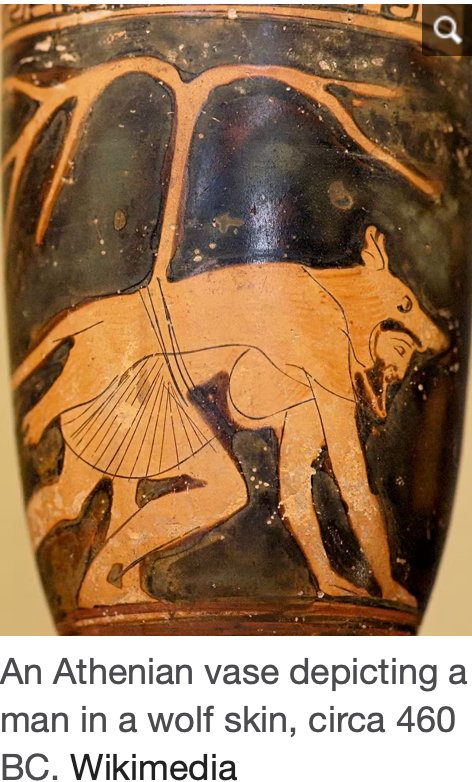Lycanthropy: Origins, Documented Cases, and Modern Interpretations of the Werewolf Legend
- alanbjones
- 30 minutes ago
- 5 min read

Lycanthropy, the mythical transformation of humans into wolves, has sparked curiosity and fear across cultures for thousands of years. The werewolf legend is deeply rooted in folklore and superstitions. It has changed and evolved, leaving behind a rich collection of stories.
The Origins of the Werewolf Legend
The werewolf legend has ancient beginnings. One of the earliest references can be found in Mesopotamian mythology: the Epic of Gilgamesh mentions a character named Enkidu, who possesses wolf-like traits. However, Enkidu is best described as a wild man created by the gods to be a companion and foil to the hero Gilgamesh. He is initially described as living among the animals, covered in hair, and wearing animal skins. However, he is not depicted as a shapeshifter or having any of the characteristics associated with werewolves.
In Greek mythology, Lycaon was a king of Arcadia who, in the most popular version of the myth, killed and cooked his son Nyctimus and served him to Zeus to see whether the god was sufficiently all-knowing to recognise human flesh.
Disgusted, Zeus transformed Lycaon into a wolf, while Nyctimus was restored to life.
Ovid’s passage is one of the only ancient sources that goes into detail on the act of transformation. His description of the metamorphosis uses haunting language that creates a correlation between Lycaon’s behaviour and the physical manipulation of his body...
…He tried to speak, but his voice broke into an echoing howl. His ravening soul infected his jaws; his murderous longings were turned on the cattle; he still was possessed by bloodlust. His garments were changed to a shaggy coat and his arms into legs. He was now transformed into a wolf.
The term "lycanthropy" comes from the Greek words "lykos" (wolf) and "anthropos" (human), highlighting the strong connection between the two.
In 425 BC, Greek historian Herodotus described the Neuri, a nomadic tribe of magical men who changed into wolf shapes for several days of the year. The Neuri were from Scythia, a land that is now part of Russia. Using wolf skins for warmth is not outside the realm of possibility for inhabitants of such a harsh climate: this is likely the reason Herodotus described their practice as “transformation”.
The werewolf myth became integrated with the local history of Arcadia, a region of Greece. Here, Zeus was worshipped as Lycaean Zeus (“Wolf Zeus”).
In 380 BC, Greek philosopher Plato told a story in the Republic about the “protector-turned-tyrant” of the shrine of Lycaean Zeus.
“The story goes that he who tastes of the one bit of human entrails minced up with those of other victims is inevitably transformed into a wolf.”

Wolves were once widespread in Europe and the Ancient world. They were an effective and efficient predator.
The Koryos is a hypothetical group of young warriors with early Proto-Indo-European roots. Lycanthropy wolf has been linked to the initiation of this warrior class. These young, unmarried warriors identified with wolves and dogs, possibly wearing their skins during rituals and exhibiting wolf-like behaviour.
The Christian church, in its efforts to combat pagan beliefs and witchcraft, heavily influenced the development of the werewolf myth in the Middle Ages. Werewolves became increasingly associated with evil, the devil, and black magic,
Authors like Augustine of Hippo addressed the concept of men turning into wolves, attributing it to witches' spells or referring to individuals who believed they were wolves as suffering from a mental delusion.
During the 16th and 17th centuries, brutal werewolf trials in France and Germany led to many accusations of lycanthropy, resulting in severe punishments. For example, between 1564 and 1620, it is estimated that at least 30 people were executed for werewolf-related offences in these regions.
Documented Cases of Lycanthropy
Though rooted in mythology, documented cases of lycanthropy have fueled the belief in this phenomenon. One striking example is Peter Stumpp, a German farmer from the 16th century. He claimed he had made a pact with the devil, allowing him to transform into a wolf and commit atrocious acts.
Stumpp was executed on 31 October 1589, alongside his daughter Beele (Sybil) and mistress, Katherine.
It was a brutal affair

He was put on a wheel, where "flesh was torn from his body", in ten places, with red-hot pincers, followed by his arms and legs. Then his limbs were broken with the blunt side of an axehead before he was beheaded and his body burned on a pyre.
His daughter and mistress had already been flayed and strangled, and were burned along with Stumpp's body. As a warning against similar behaviour, local authorities erected a pole with the torture wheel and the figure of a wolf on it, and at the very top, they placed Peter Stumpp's severed head.
Little Red Riding Hood.
We all know the story: the girl, the woods and the granny who a wolf replaces.
Some early oral traditions and versions of the story depict the wolf as a "bzou," which is a werewolf-like creature. The association with werewolves is relevant because the story may have originated during a time when werewolf trials were common, suggesting a possible influence.
There are versions of this story where the wolf eats the grandmother's flesh and blood and asks the girl to disrobe before getting into bed, mirroring elements found in werewolf lore.
In the Grimm brothers' telling, a huntsman rescues Red Riding Hood and her grandmother, while Charles Perrault's earlier version ends with the wolf eating them both and includes a moral about not trusting strangers.
Over time, the story shifted away from the werewolf aspect, focusing more on the wolf as a predator and a symbol of danger.
Modern Interpretations of Lycanthropy
In today’s culture, the portrayal of werewolves has shifted dramatically. Once solely figures of horror, werewolves now symbolise complexity, reflecting the struggle between civilisation and primal instincts. This evolution is evident in various forms of media, including movies and television shows.
The classic film "The Wolf Man" (1941) helped cement the werewolf’s role in horror.
"Even a man who is pure in heart and says his prayers by night may become a wolf when the wolfbane blooms and the autumn moon is bright."
More recent portrayals, such as those in 'Amercian Werewol in London"; the "Twilight" series and "Teen Wolf," depict werewolves as relatable characters, grappling with their identity rather than merely acting as villains.
This modern take speaks to a larger cultural interest in exploring identity and the supernatural. The werewolf has become a metaphor for the inner conflicts many face in balancing personal desires with societal expectations. This theme resonates widely with audiences, making werewolves captivating figures in storytelling today.
The Symbolism of the Werewolf
The werewolf legend carries rich symbolism, representing humanity's conflict with nature. The transformation from human to wolf suggests primal instincts bubbling beneath the surface. This duality raises essential questions about our nature and the thin line between civilisation and our wild roots.
In many cultures, wolves symbolise loyalty, family, and instinct. The werewolf, then, embodies the struggle to balance these instincts with society's demands. This theme feels especially relevant in a world where people often feel torn between their desires and social norms.
Additionally, the werewolf myth often explores themes of transformation and self-discovery. Becoming a werewolf can signify personal growth, as characters come to terms with their fears and identities. This narrative arc connects with audiences and makes the werewolf a compelling figure across literature and film.
Final Thoughts on Lycanthropy
The legend of lycanthropy is more than just a story; it reflects deep-seated human experiences and fears. From its origins to modern interpretations, the werewolf symbolises the duality of human nature. Through this legend, we reveal the timeless tension between our primal instincts and societal pressures.
As the werewolf myth continues to grow, it acts as a mirror, reflecting our fascination with the unknown and the complexities of being human. Whether seen as a monster or a misunderstood being, the werewolf will continue to captivate our stories and stir our imaginations for years to come.
Alan /|\



Comentários